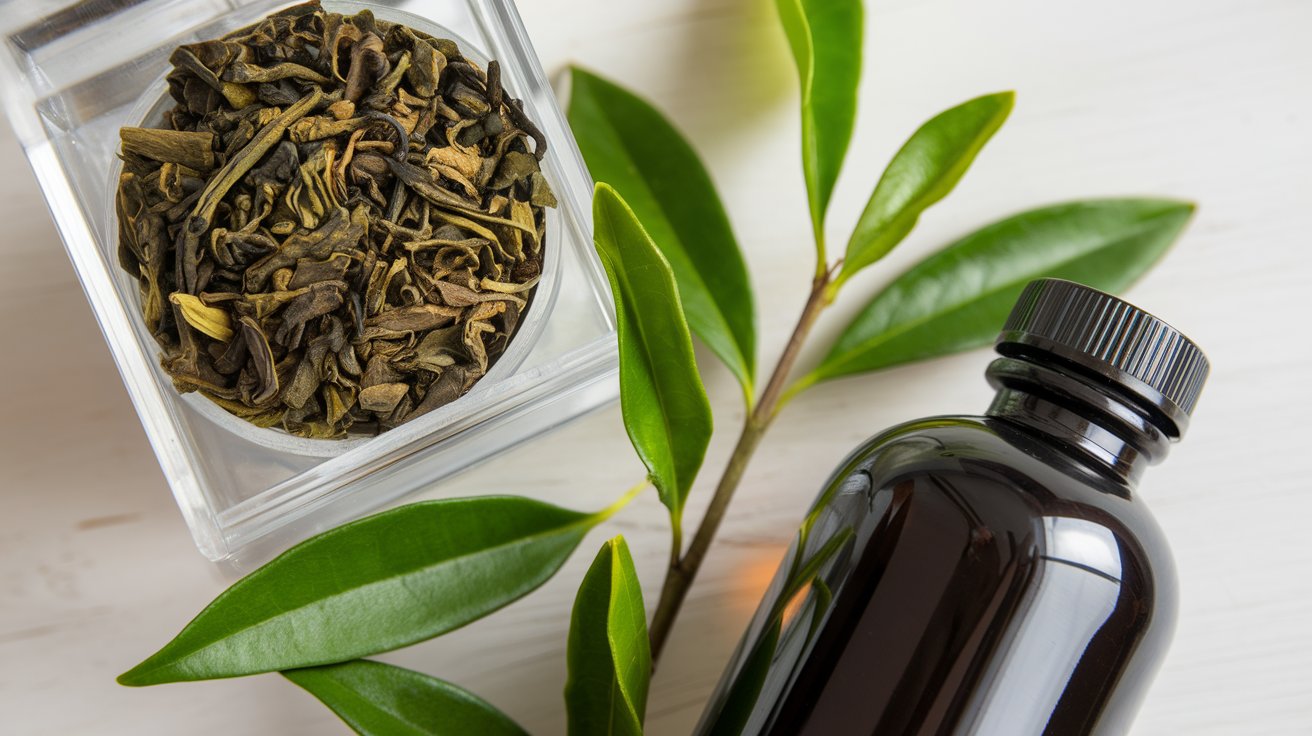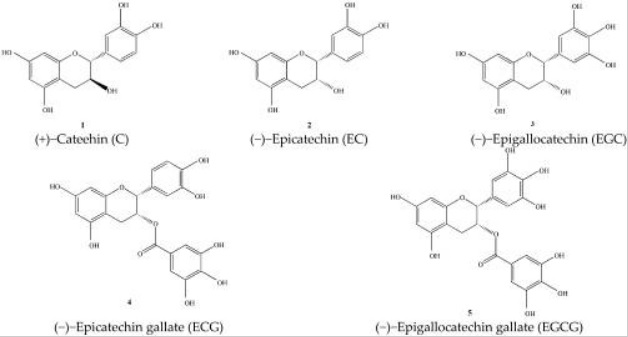heading_title

Green tea infusion is even an icon of health. When asked what beverage is worth drinking for health, many people will immediately think of green tea. Without a doubt, it can be considered a functional food, which we include in our diet not only to please our senses, but also because of its above-average value for health. Dietary supplements with extracts from this plant are also very popular, allowing you to easily enjoy the benefits of green tea in a concentrated way, even when you don't like its aroma or don't want to prepare daily infusions from dried tea.
In this article, we'll examine the composition of green tea and its potential health benefits, from its effects on body weight to its anti-cancer benefits. Read to the end!
- Green tea extract and its benefits
- Different types of green tea extracts
- Black tea versus green tea - the difference
- EGCG as green tea's greatest asset
- Other components of green tea
- Health benefits of green tea supplementation
- Potential risks and recommended dosage of green tea extract
- Synergy with other dietary supplement ingredients
- Summary
Green tea extract and its benefits
The health benefits of green tea are mainly attributed to its polyphenol content, particularly flavanols and flavonols, which make up as much as 30% of the dry weight of fresh leaves[1]. Many of the beneficial effects of green tea are specifically attributed to the most abundant catechin: (-)-epigallocatechin-3-gallate (EGCG).
In clinical studies, researchers have analyzed such effects of green tea[1][2], among others:
- cancer prevention,
- prevention of cardiovascular disease,
- lowering blood pressure,
- anti-inflammatory effects,
- lowering blood sugar,
- anti-arthritic,
- antimicrobial,
- anti-angiogenic,
- antioxidant,
- antiviral,
- neuroprotective,
- cholesterol-lowering.
The first green tea was exported from India to Japan in the 17th century. An estimated 2.5 million tons of tea leaves are produced worldwide each year, 20% of which is produced as green tea. It is consumed mainly in Asia, parts of North Africa, the United States and Europe[1].
From the early 19th century to the present, it has been reported that more than 500 chemical constituents have been isolated from tea, including more than 400 organic compounds and more than 40 inorganic compounds[2].
Different types of green tea extracts
Green tea is a wealth of active substances, which is also evident in the variety of extracts. They can be standardized to different active ingredients, and examples include:
- 98% polyphenols, 70% catechins and 50% EGCG
- 98% L-theanine
- 40% catechins and 8% caffeine
The first variant (or close to it) is the most commonly used raw material in supplements. If you want to benefit from the health properties attributed to green tea, this should be your best choice. These types of supplements sometimes also have a declaration that the extract is purified from caffeine. This is an advantage for people who avoid it.
The second option is virtually pure L-theanine extracted from green tea leaves. In this case, expect benefits specific to L-theanine, without the effects observed with the consumption of EGCG or green tea infusions. So it will be mainly calming, stress reduction and the possibility of nootropic effects.
The third is relatively rare. It is a less concentrated extract and has fewer catechins, but it also has not been stripped of caffeine. So it is a choice for people who also want to enjoy a slightly energizing effect.
Black tea versus green tea - the difference
Many people are surprised by this, but in both cases it is Camellia sinensis. It is exactly the same plant! However, the difference comes in the production process. To make black tea, the leaves must ferment after harvesting. To make the tea green, growers protect the leaves from the fermentation process. This involves exposing the leaves to steam, which degrades the enzymes responsible for breaking down the color pigments in the leaves and allows the tea to retain its green color during subsequent rolling and drying processes. This also ensures that most of the polyphenols are not metabolized into other compounds and remain in their original form.
Although the leaves are the same in both cases, the manufacturing process changes a lot. Green tea not only has a different color and aroma, but also differs greatly in its chemical composition. Of all teas, it is green tea that has been noted to have the greatest impact on human health.
EGCG as green tea's greatest asset
Green tea leaves are very abundant in polyphenols, which comprise an impressive 30% of their dry weight. Most of them are catechins (flavonols). Among them we distinguish 5 substances:
- catechin
- epicatechin,
- epigallocatechin,
- epicatechin-3-gallate,
- epigallocatechin gallate, or EGCG.

Graphic source - doi:10.3390/molecules27123909
Of this bunch, EGCG is considered the substance with the greatest pharmacological activity and has received the most attention from scientists. It is also found in the greatest quantity, as EGCG is more than 50% of all catechins in Camellia sinensis leaves.
Catechins are responsible for the vast majority of the benefits attributed to green tea, with the other constituents being more complementary.
EGCG acts as a potent antioxidant, preventing oxidative damage in healthy cells, but also as an anti-angiogenic and anti-tumor agent, and as a modulator of the response of cancer cells to chemotherapy[3]. Many of the chemopreventive properties of green tea are indirectly caused precisely by epigallocatechin gallate.
An average cup of green tea infusion contains about 50 mg of EGCG. Already such doses are beneficial, but in supplementation the standard doses used are slightly higher.
Other components of green tea
The chemical composition of green tea is complex. In addition to catechins, green tea leaves contain[1][2]:
- Proteins (15-20% of dry weight), including enzymes;
- amino acids (1-4% of dry weight) such as theanine or 5-N-ethylglutamine, glutamic acid, tryptophan, glycine, serine, aspartic acid, tyrosine, valine, leucine, threonine, arginine and lysine;
- carbohydrates (5-7% of dry weight) such as cellulose, pectin, glucose, fructose and sucrose;
- minerals and trace elements (5% of dry weight) such as calcium, magnesium, chromium, manganese, iron, copper, zinc, molybdenum, selenium, sodium, phosphorus, cobalt, strontium, nickel, potassium, fluorine and aluminum;
- Trace amounts of lipids (linoleic acid and α-linolenic acid),
- sterols (stigmasterol),
- vitamins (B, C, E),
- xanthine bases (caffeine, theophylline),
- pigments (chlorophyll, carotenoids),
- volatile compounds (aldehydes, alcohols, esters, lactones, hydrocarbons),
- flavonoids (glycosides of quercetin and myricetin),
- anthocyanins (malvidin, cyanidin, delphinidin, pelargonidin, petunidin),
- phenolic acids (gallic, chlorogenic, coffee, p-coumaric, ellagic, quinic).
Health benefits of green tea supplementation
Below is an overview of the most important health properties of green tea, along with data from the scientific literature.
Antioxidant effects
It was reported as early as 1997 that green tea extract and its three main components, including tea polyphenols, theanine and caffeine, have the ability to effectively inhibit copper-catalyzed lipid peroxidation[2]. Protection against free radicals is a key role that green tea plays in the body.
Effective reduction of free radicals is green tea's greatest superpower. The strong antioxidant potential is influenced in particular by the high content of catechins. The ability of antioxidant compounds in green tea to fight free radicals has been classified as[2]:
EGCG > ECG > EGC > EC
It is therefore confirmed that epigallocatechin gallate is the most efficient of the tea catechins.
The mechanism of antioxidant action involves an increase in ROS scavenging efficiency by increasing the activity of antioxidant enzymes, such as:
- superoxide dismutase (SOD),
- catalase (CAT),
- glutathione peroxidase (GSH-Px),
- glutathione reductase (GSH-Rd).
Effects on the nervous system and mood
Green tea is rich in polyphenols, and polyphenols easily enter the brain. As a result, we have many reports of theneuroprotectivepotential of green tea infusions and extracts. Many experimental studies have noted beneficial effects in an Alzheimer's disease model, including that green tea extract selectively inhibits acetylcholinesterase. Beneficial effects of EGCG on protecting the brain from the development of Parkinson's disease have also been noted in an animal model[2].
Often supplements for energy or mood enhancement just have green tea extracts in their formulation. Although in green tea it is mainly caffeine and theanine that have been linked to effects on mood and cognitive abilities, there are isolated indications of beneficial properties for EGCG as well. In one study, just a single dose of 300 mg of EGCG resulted in greater feelings of calmness and stress reduction within two hours of consumption[4]. In another study, an 8-week intake of 800 mg of EGCG per day resulted in an overall improvement in mood and fewer feelings of tension[4]. These effects are most likely at least partially due to EGCG's affinity for GABA receptors, our main calming neurotransmitter.

Anti-cancer effects
The anti-cancer aspect has been the focus of many studies involving green tea. The most important mechanisms pointed out by researchers are[2]:
- inhibition of migration and invasion of cancer cells;
- induction of apoptosis;
- inhibition of angiogenesis of cancer cells;
- inhibition of cancer cell proliferation.
In vitro studies have shown that EGCG blocks carcinogenesis by affecting multiple signal transduction pathways[3]. EGCG stimulates telomere fragmentation by inhibiting telomerase activity[3]. Various clinical studies have shown that EGCG intake inhibits the occurrence and multiplicity of cancers in various organ sites, such as the liver, stomach, skin, lungs, mammary glands and colon.
Effects on the cardiovascular system
Improved lipid profiles, lowered blood pressure and reduced overall cardiovascular mortality are often reported in research conclusions. It can even be argued that the effect on the heart and blood vessels is one of the strongest benefits of green tea.
The effects of green tea on cardiovascular health are well summarized by a 2016 meta-analysis[5]. It qualified nine studies involving a total of 259267 people. The results showed that people who did not drink green tea had a higher risk of cardiovascular disease, intracerebral hemorrhage and cerebral infarction compared to those who drank <1 cup of green tea per day. Thus, it can be seen that even small amounts of green tea make a difference. Larger amounts, however, produced better results. People drinking 1-3 cups of green tea per day had a reduced risk of myocardial infarction and stroke compared to those drinking <1 cup per day.
Another interesting meta-analysis was published in 2022[6]. It showed that green tea supplementation was associated with a small but significant improvement in lipid profile by reducing total cholesterol and LDL while increasing HDL. In addition, a significantly beneficial effect on triglycerides was noted with long-term supplementation. Green tea also showed beneficial effects on the glycemic profile by reducing fasting glucose and HbA1c, but without any changes in fasting insulin or HOMA-IR. A small but significant decrease in diastolic blood pressure was also observed.
Although the exact mechanism of green tea's action to lower cholesterol is not fully understood, increased thermogenesis, increased gene expression of enzymes involved in bile acid production and suppression of appetite have been proposed as potential mechanisms[6].
So, if your goal is to prevent cardiovascular disease, drinking green tea regularly or using extracts of its leaves would be a great idea. Cardiovascular disease is the leading cause of death worldwide, so it's undoubtedly worth doing what you can to reduce your risk.
Effect on body weight
The popular view is that green tea is a good choice when weight loss is the goal. Is this actually the case?
It must be admitted that the evidence for the slimming effects of green tea is mixed. In scientific databases, one can come across both positive information and reports of meager effects.
For example, great effects were noted in a 12-week study on women with obesity. During that time, they took 856.8 mg of EGCG from green tea each day. The results actually noted a significant weight loss with improved lipidogram. The authors suggest that this was due to green tea's effect on reducing ghrelin secretion and increasing adiponectin[7]. Although no adverse effects were noted with this study, it is worth noting that the dose of EGCG used exceeded current recommendations and in some cases may adversely affect health.
It is reasonable to assume that when the only action we take is supplementation with green tea extract in recommended, moderate doses, the weight loss will not be drastic. There is even a humorous saying that green tea is best for weight loss when you pick it yourself from a mountainside before consuming it.
However, green tea extracts are used as ingredients in complex fat burners, and that's how most make sense. There are many rationales in scientific publications showing the benefits of green tea supplementation in terms of glycemia, support of postprandial thermogenesis and inhibition of lipogenesis[1].
Potential risks and recommended dosage of green tea extract
It is important to remember that "natural" does not mean completely safe. This is the case with many plants, and green tea is no exception.
Experts warn not to exceed an intake of 800 mg of EGCG per day. While moderate amounts of green tea catechins are very healthy for us, excess EGCG can be cytotoxic and even induce acute cytotoxicity in liver cells. In addition, a study on hamsters showed that higher consumption of green tea can cause oxidative DNA damage to the pancreas and liver.
The source of some of the problems may be choosing green tea from unreliable sources and aluminum contamination. People with kidney disease should pay special attention to this.
Also beware of interactions with certain metals. Green tea catechins impair the absorption of iron and zinc ions[1]. If you are supplementing with these minerals and want to include green tea supplementation, make sure to take the proper interval between supplements. Don't take green tea supplements around meals containing iron and zinc if you don't want to impair their absorption.
Synergy with other dietary supplement ingredients
To get the most out of your supplements' potential, it's best to combine them in the right way so that they work well together and provide far greater benefits than each one alone. In the case of green tea extracts, there are several synergies to consider.
Green tea + other antioxidants
Often green tea extracts are combined with antioxidants such as quercetin, grape seed OPC or trans-resveratrol. In many cases, they either enhance each other's effects in certain aspects, or complement each other and add new properties. Particularly for anti-aging or cardiovascular support, combinations of different antioxidants/polyphenols are used like this.
EGCG + 5-HTP or L-DOPA
5-HTP and L-DOPA are precursors for the production of serotonin and dopamine, respectively. Both are of natural origin: 5-HTP is extracted from the seeds of the African black bean(Griffonia simplicifolia), while L-DOPA is extracted from the scabies proper(Mucuna pruriens). In supplementation, they are mainly used to improve well-being.
Epigallocatechin gallate and epigallocatechin are considered inhibitors of the enzyme DOPA decarboxylase[8]. What does this mean? DOPA decarboxylase (DDC) is an enzyme that converts L-DOPA to dopamine and 5-HTP to serotonin. By inhibiting it with catechins, it reduces the conversion to dopamine and serotonin in peripheral tissues. This allows L-DOPA and 5-HTP to reach the brain in greater amounts and be converted to target neurotransmitters there. This is important because dopamine and serotonin produced in the peripheral blood are unable to reach the brain and will not affect mood. To get the right effect, these neurotransmitters must be produced directly in the brain.
EGCG + thermogenic herbs
Green tea extracts with high EGCG content are often combined with ginger, black pepper or cayenne pepper extracts, among others, as part of multi-ingredient supplements designed to help burn fat. There are numerous reports in the literature of EGCG enhancing postprandial thermogenesis and enhancing the thermogenic properties of caffeine, for example.
Summary
As to the fact that green tea is healthy, rather no one doubts. All you need to do is drink it regularly or include supplementation to reap the benefits. The powerful antioxidants in green tea leaves have a clear impact on overall health, with the greatest emphasis on the cardiovascular system, cancer prevention and metabolic health. Is green tea worth using? Still how! However, in doing so, it is worth remembering that what is too much is unhealthy. Daily doses of EGCG should be moderate, preferably below 800 mg.
Sources:
 ⮜ Previous article
⮜ Previous article
Nootropics - pills for memory, concentration and well-being
 Next article ⮞
Next article ⮞